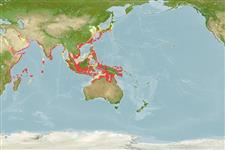ກຸ່ມປາກະດູກອ່ອນ (ເຊັ່ນ: ປາສະຫລາມ, ປາຜາໄລ) (sharks and rays) >
Rhinopristiformes (Shovelnose rays) >
Pristidae (Sawfishes)
Etymology: Anoxypristis: Greek, ana = up + Greek, oxy = sharp, pointed + Greek, pristis = saw (Ref. 45335).
Environment: milieu / climate zone / ລະດັບຄວາມເລິກ / distribution range
ນິເວດວິທະຍາ
ສັດທະເລ; ນ້ຳຈືດ; ນ້ຳກ່ອຍ ກ່ຽວກັບ (ຢູ່)ເທິງຊັ້ນພື້ນດິນໃນທະເລເປີດ; ປາທີ່ມີການເຄື່ອນຍ້າຍຈາກທະເລໄປຫານ້ຳຈືດ ແລະນ້ຳຈືດຫາທະເລ (Ref. 51243); ລະດັບຄວາມເລິກ 0 - 40 m (Ref. 9859), usually ? - 40 m (Ref. 55270). Tropical; 43°N - 20°S, 30°E - 160°E (Ref. 114953)
Indo-West Pacific: widespread, Red Sea to eastern Australia, north to Japan.
Length at first maturity / ຂະໜາດ / ນ້ຳໜັກ / Age
ການຈະເລີນເຕັມໄວ: Lm 264.0, range 246 - 282 cm
Max length : 470 cm TL ຕົວຜູ້/ບໍ່ມີເພດ; (Ref. 9859)
Greyish above, pale below; fins usually pale. Body shark-like, pectoral fins distinct; head flattened, with a blade-like snout bearing 18-22 pairs of lateral teeth; blade slender, not tapering distally. Nostrils very narrow with small nasal flaps. Rostral teeth short, flattened, broadly triangular, lacking a groove along posterior margins; no teeth on basal quarter of blade. Adults with widely spaced denticles, young with naked skin.
Body shape (shape guide): elongated.
Found inshore, often in river deltas and estuaries; penetration well up rivers needs confirmation (Ref. 9859). Common in sheltered bays with sandy bottoms. More active swimmer than other sawfishes (Ref. 114953). Feeds on small fish, cuttlefish (Ref. 9859) and small benthic invertebrates such as prawns (Ref. 114953). Ovoviviparous (Ref. 50449). Most fecund sawfish, reported to reach sexual maturity at 2-3 years (Ref. 114953). Females have litters of approximately 12 pups (Ref. 114953). Generally harmless but its saw-like snout may cause serious injury when caught: it is known thrash violently and vigorously (Ref. 9859). Caught for its flesh and liver (which is rich in oil) in some parts of Asia (Ref. 6871). Maximum lengths of up to 610 cm TL are based on unconfirmed reports (Ref. 9859).
Life cycle and mating behavior
ການຈະເລີນເຕັມໄວ | ການສືບພັນ | ການວາງໄຂ່ | ໄຂ່ | ຄວາມດົກຂອງໄຂ່ປາ | ຕົວອ່ອນ
Ovoviviparous. Litter size from 6 to 23, young born in the spring (Ref. 9859).
Mould, B., 1994. A world list of rays. The scientific nomenclature and distribution of the recent Batoidea (Batoidea, Elasmobranchii, Chondrichthyes). University of Nottingham, [UK]. 82 p. (Ref. 8630)
IUCN Red List Status (Ref. 130435: Version 2025-1)
Human uses
ການປະມົງ: ເປັນສີນຄ້າ; ຊະນິດປາທີ່ຖືກນຳໃຊ້ເຂົ້າໃນການຫາເພື່ອເປັນເກມກິລາ: ແມ່ນ
ເຄື່ອງມື
Special reports
Download XML
ແຫຼ່ງອີນເຕີເນັດ
Estimates based on models
Preferred temperature (ເອກະສານອ້າງອີງ
123201): 24.6 - 29.1, mean 28.2 °C (based on 1982 cells).
Phylogenetic diversity index (ເອກະສານອ້າງອີງ
82804): PD
50 = 1.0078 [Uniqueness, from 0.5 = low to 2.0 = high].
Bayesian length-weight: a=0.00490 (0.00195 - 0.01230), b=3.05 (2.83 - 3.27), in cm total length, based on LWR estimates for this (Sub)family-body shape (Ref.
93245).
ຊັ້ນເຂດຮ້ອນ (ເອກະສານອ້າງອີງ
69278): 4.5 ±0.62 se; based on food items.
ຄວາມຢືດຢຸ່ນ (ເອກະສານອ້າງອີງ
120179): ຕຳ່, ປະຊາກອນຕຳ່ສຸດທີ່ໃຊ້ເວລາສອງເທົ່າ 4.5 - 14 ປີ (Fec assumed to be <100).
Fishing Vulnerability (Ref.
59153): Very high vulnerability (90 of 100).
🛈
